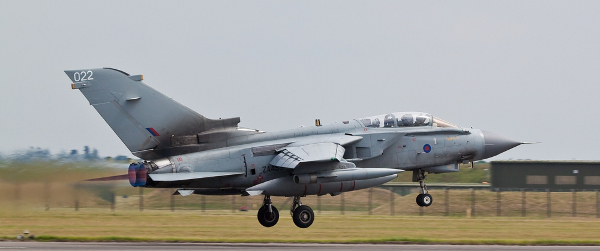
British jets have successfully taken to the skies with parts made from 3D printing technology, BAE Systems has said.
Metal components were fitted to RAF Tornado GR4 fighter jets that flew test flights from the defence firm’s airfield in Lancashire last month.
Some of the 3D-printed parts include protective covers for radios.
It is claimed that by using 3D printing technology, the RAF could save over £1.2m on maintenance and service over the next four years.
Some of the parts, being manufactured for the Tornado GR4 squadrons at RAF Marham in Norfolk, cost less than £100.
Mike Murray, head of airframe integration at BAE Systems, said: "You are suddenly not fixed in terms of where you have to manufacture these things. You can manufacture the products at whatever base you want, providing you can get a machine there, which means you can also start to support other platforms such as ships and aircraft carriers.
"And if it’s feasible to get machines out on the front line, it also gives improved capability where we wouldn’t traditionally have any manufacturing support."
Last year, Rolls Royce also announced that it will be making parts for its jet engines from 3D printing.
Rolls Royce technology strategy head Henner Wapenhans was cited by the Financial Times as saying that the new technology could produce parts more quickly, slashing lead times.
"3D printing opens up new possibilities, new design space," Wapenhans said.
"Through the 3D printing process, you’re not constrained [by] having to get a tool in to create a shape. You can create any shape you like.
"There are studies that show one can create better lightweight structures, because you just take the analogy of what nature does and how bones are built up – they’re not solid material.
"And so things that are simple things like brackets can be made a lot lighter."
The European Space Agency has already experimented with 3D-printed metal components for rockets and spacecraft.
The AMAZE (Additive Manufacturing Aiming Towards Zero Waste & Efficient Production of High-Tech Metal Products) program is working to create complex shapes that are impossible to manufacture with traditional casting and machining techniques.
"We are at the cusp of the third industrial revolution," said Hilde Loken Larsen of Norsk Titanium AS, who supplies materials to the ESA.
With their printing methods, little to no material is wasted and by cutting the number of steps in a manufacturing chain offers enormous cost benefits.
"Don’t think about the printing plastics that you’ll see in schools, this is the real stuff," said Nick Cox of the UK Space Agency.
Researchers at AMAZE have already started manufacturing metal rocket and jet engine parts, with aerospace wing sections getting up to two meters in size.
With the additive manufacturing processes, the high-strength components are built with minimal waste, as only the metal needed is used. This differs from traditional casting techniques, where huge amounts of scrap are produced trying to achieve the final product.
"To produce one kilo of metal, you use one kilo of metal, not 20 kilos," said ESA’s Franco Ongaro, the director of Technical and Quality Management.
Looking to the future, Franco Ongaro said: "The real dream is to go into electronics."
Across the Atlantic, NASA is preparing to send a 3D printer to the International Space Station after it passed a series of key microgravity flight tests.
Three prototype versions of space manufacturing startup Made in Space’s 3D printer showed their stuff during four airplane flights that achieved brief periods of microgravity via parabolic maneuvers.
"We demonstrated that our 3D printers can print in microgravity," Made in Space strategic officer Mike Chen said in a statement.
"Next year, we will demonstrate that they can print on the International Space Station."
The main goal of the project is to help jump-start an off-planet manufacturing capability, which proponents say could aid humanity’s push out into the solar system by making living in space easier and cheaper.
"The 3D printer we’re developing for the ISS is all about enabling astronauts today to be less dependent on Earth," Noah Paul-Gin, Made in Space’s microgravity experiment lead, said in a statement.
"The version that will arrive on the ISS next year has the capability of building an estimated 30 percent of the spare parts on the station, as well as various objects such as specialty tools and experiment upgrades."






